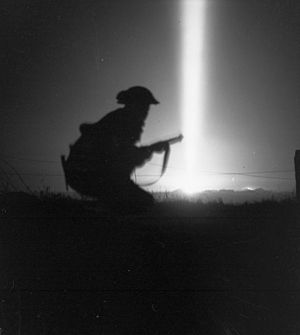Operation Spring facts for kids
Quick facts for kids Operation Spring |
|||||||
|---|---|---|---|---|---|---|---|
| Part of Operation Overlord, Battle of Normandy | |||||||
 Operation Spring |
|||||||
|
|||||||
| Belligerents | |||||||
| Commanders and leaders | |||||||
| Guy Simonds | Josef Dietrich | ||||||
| Strength | |||||||
| 2 infantry divisions 2 armoured divisions 1 armoured brigade |
Parts of 3 panzer divisions 1 depleted infantry division Parts of two Tiger battalions |
||||||
| Casualties and losses | |||||||
| 450 killed 1,100 wounded |
|||||||
Operation Spring was an important military action during World War II. It took place from July 25 to 27, 1944, as part of the larger Normandy campaign. Canadian soldiers led this attack. Their goal was to push back German forces and capture a key area called Verrières Ridge. This operation was planned to happen at the same time as a big American attack called Operation Cobra.
Contents
Why This Battle Happened
The Goal: Verrières Ridge
After the Allies landed in Normandy, they needed to capture more land. The city of Caen was a major target. British and Canadian forces had already fought hard to take parts of Caen in earlier battles.
About 8 kilometers (5 miles) south of Caen was Verrières Ridge. This high ground was very important. It blocked the Allied forces from moving further south towards the town of Falaise. The Germans had strong defenses on this ridge. Previous attempts to capture it had failed.
Planning the Attack
The Canadian Plan
The Canadian forces, led by Lieutenant-General Guy Simonds, made a detailed plan for Operation Spring. The attack was divided into several steps. Canadian infantry and armored divisions would work together.
Their main goals were to capture Verrières Ridge itself. They also aimed to take nearby villages like May-sur-Orne, Fontenay-le-Marmion, and Tilly-la-Campagne. The plan involved different Canadian brigades attacking specific areas. They would have strong support from many artillery guns.
German Preparations
The German army knew the Allies would try to attack Verrières Ridge again. So, they sent many more soldiers and tanks to strengthen their defenses. They brought in powerful Panzer (tank) divisions. These included the 1st SS Panzer Division and the 116th Panzer Division.
The Germans also had strong artillery and anti-tank guns ready. They set up their defenses carefully. They wanted to stop the Allied advance at all costs. They were prepared for a tough fight.
The Battle Begins
First Attacks: July 25
The attack started early on July 25, at 3:30 AM. Canadian soldiers from The North Nova Scotia Highlanders attacked Tilly-la-Campagne. They used special searchlights to see in the dark. This helped them see the German positions, but it also made them easier for the Germans to spot. They managed to capture the village.
To their west, The Royal Hamilton Light Infantry faced strong resistance. But they fought hard and secured Verrières village by 5:30 AM.

Struggles for May-sur-Orne
Later on July 25, the Calgary Highlanders attacked May-sur-Orne. They found that some areas they expected to be clear were still held by German troops. Two companies of soldiers tried to bypass the Germans. They reached the edge of May-sur-Orne, but then lost radio contact. Both companies suffered many casualties.
The Calgary Highlanders eventually secured their first objective. But they had to fight two costly battles to hold onto May-sur-Orne.
Heavy Losses on Verrières Ridge
The attack on Verrières Ridge itself was very difficult. The Essex Scottish Regiment and South Saskatchewan Regiment had tried before and failed. This time, the Black Watch regiment led the attack. They faced very strong German resistance.
When the attack on Verrières Ridge began, the Canadian soldiers were fired upon from three sides. German units were in a factory area, on the ridge, and even across the Orne River. Within minutes, communications broke down. The Black Watch lost almost all of its attacking soldiers. It was one of the deadliest days for Canadian forces in the war.
German Counter-attacks
For several days after the main attack, German troops fought back hard. They tried to take back the areas the Canadians had gained. The 9th and 12th SS Panzer divisions led many of these counter-attacks.
The Calgary Highlanders had to pull back from May-sur-Orne. The North Nova Scotia Regiment was also forced to retreat from Tilly-la-Campagne. German forces immediately counter-attacked Verrières village. But the Royal Hamilton Light Infantry (RHLI) fought bravely and held their ground. They defended the ridge against many German attacks. Over two days, the RHLI suffered more than 200 casualties.
German counter-attacks also forced other Canadian units, like the Queen's Own Cameron Highlanders and the Black Watch, to retreat from May-sur-Orne and St Martin.
Aftermath
Operation Spring was a very tough battle for the Canadian forces. They faced strong German defenses and suffered many casualties. While they did capture some areas, they could not fully achieve their main goal of taking Verrières Ridge. The Germans managed to hold onto the ridge, making it a German victory.



